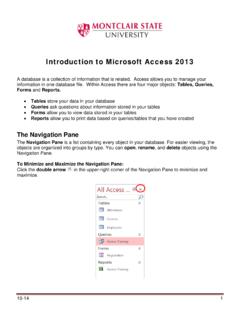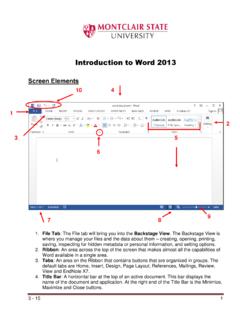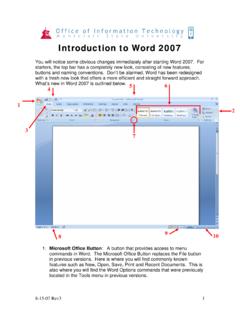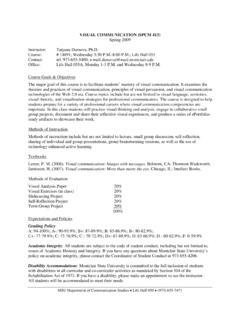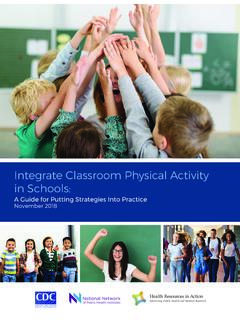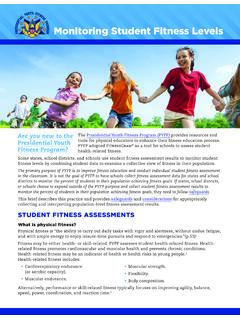Transcription of Use of Technology for Constructivist Learning in a ...
1 MEASUREMENT IN physical EDUCATION AND EXERCISE SCIENCE, 10(1), 67 78. Copyright 2006, Lawrence Erlbaum Associates, Inc. Use of Technology for Constructivist Learning in a Performance Assessment Class Susana Juniu Health Professions, physical Education, Recreation, and Leisure Studies Montclair State University The use of educational technologies in teaching and Learning presents pedagogical concerns and challenges to educators. Combining multimedia technologies with the Web has created new possibilities for the development of instructional materials to deliver course content. However, this use of Technology continues to represent tradi- tional conceptions regarding the use of computers. The question remains as to when and how to use various forms of educational Technology and how to best integrate them into the classroom . Disciplines such as measurement and evaluation are not free from these challenges, especially when instructors are looking for ways to improve Learning of statistical concepts that are hard to retain.
2 Using educational Technology as a Constructivist tool could aid students to represent their ideas, articulate what they know, and explore, manipulate, and process information, while actively collaborat- ing with each other (Jonassen, Peck, & Wilson, 1999). The purpose of this article is to describe Constructivist uses of Technology and to present a curriculum unit for a per- formance assessment class in health and physical education, which is presented as an example of a project-based Learning activity that exemplifies a Constructivist use of software to support problem solving. Key words: educational Technology , project-based Learning , health-related physical fitness The evolving information Technology era has become a major challenge for higher education institutions. Instructors are compelled to incorporate educational tech- Correspondence should be sent to Susana Juniu, Department of Health Profession, physical Educa- tion, Recreation and Leisure Studies, Panzer Gym 217, Montclair State University, Upper Montclair, NJ 07043.
3 E-mail: 68 JUNIU. nology in the classroom , but often these technologies are used as productivity tools to deliver information rather than as cognitive means to support Learning . Ques- tions such as how educational Technology impacts teaching and Learning and how to best integrate it into the classroom present pedagogical concerns. Disciplines such as measurement and evaluation are not free from these challenges. Instructors look for ways to improve Learning considering that statistical concepts are hard to retain and the students often find it difficult to make connections between the con- cepts and their own reality (Looney, 2000). Thus, creating a context that emulates real-life problems and settings is fundamental in helping students integrate , ana- lyze, and apply concepts of statistics. Educational Technology has the potential to support this approach if used to encourage the construction of knowledge through activities that are socially situated in a meaningful and authentic context (Palincsar & Klenk, 1993; Reid, 1993).
4 CONSTRUCTION OF KNOWLEDGE. The concept of meaning making is the essence of the constructivism philosophy of Learning . Constructivists believe that students construct their own meaning through active engagement and by constructing their own representation of what they know. Students learn from thinking and doing, and thinking results from an activity (Jonassen, Peck, & Wilson, 1999). In the Constructivist classroom , stu- dents interact with the environment and create their own interpretation of the world instead of being mere recipients of information transmitted by the instructor (Jonassen, 2000). The instructor motivates students by proposing a topic or pre- senting a case with emphasis on the big concept. The purpose is to trigger students'. curiosity to investigate and learn more on the topic. Edelson, Salierno, Matese, Pitts, and Sherin (2002) proposed a learn- ing-for-use model to encourage the learner to develop useful knowledge and pro- vide guidance to instructors on how to design Learning activities that foster useful understanding.
5 This approach, closely related to the Constructivist views, offers students an opportunity for acquiring knowledge that will be applied to practical situations and for reflecting on the content learned (Bazilion & Braun, 1998;. Jones, 1996). Collaboration is another element in the Learning process. The combination of doing and Learning and the value of teamwork have the potential to elicit changes within the individual. The construction of meaning through project-based Learning is an approach that facilitates problem-solving activities among learners, and it is viewed as a process that is problem oriented and encourages collaboration (Moursound, 1999). Students are presented with activities that reflect the com- plexity of the environment and the problems they will encounter in the real world Constructivist Learning 69. (Jones, 1996); thus, creating an activity that encourages inquiry and collaboration is the key to engaging students in meaningful Learning . With this premise in mind, the following sections of this article describe Constructivist uses of educational Technology and present a curriculum unit for a performance assessment class in health and physical education using a pro- ject-based Learning activity that exemplifies uses of software to support problem solving.
6 USE OF EDUCATIONAL Technology . IN Constructivist Learning . Educational Technology plays an important role in meeting the goals and objec- tives of project-based Learning and facilitates the students' exploration and reflec- tion on the content. Using the power of the Internet to distribute courseware is one example of how technological tools have been applied in academic settings. Com- bining multimedia technologies with the World Wide Web has created new possi- bilities for the development of instructional materials as well as for the delivery of instruction; however, these technologies are often used as productivity tools to dis- seminate knowledge through lectures, drill and practices, and tutorials. In this case, the Technology drives the curriculum rather than being integrated into the ex- isting curriculum. Simply using Technology tools does not ensure a quality educa- tion; how educators use Technology is more important than whether they use it. The question is when and how to use educational Technology .
7 According to con- structivist theory, various technologies may be used to promote Learning . Computer software used as Mindtools support interactive, collaborative, and student-centered classrooms. Jonassen et al. (1999) indicated that the concept of Mindtools describes a way to use computer programs to foster critical thinking (p. 156). Mindtools are computer applications that facilitate cognitive processing and engage students in critical, higher order thinking about the content (Jonassen, 2000). For example, the learner is responsible for recognizing and organizing pat- terns of information, whereas the computer performs the calculations, and stores and retrieves the information necessary to create and reflect on the patterns. In this way, the students learn with Technology rather than receive information from the computer (Jonassen et al., 1999). Software for inquiry-based activities such as da- tabases, spreadsheets, simulations, and multimedia support thinking activities and help students to express and articulate what they know by doing and creating their own representation of the problem.
8 Access, a Microsoft program for creating and maintaining databases, is a computer tool used to store and organize information, but how could it be used to promote problem-solving and critical-thinking skills? Databases enable the learner to create and/or customize information such that it can be organized and 70 JUNIU. sorted to answer queries. Having students create databases and reports and later relate them to the concepts studied is an example of purposeful Learning that re- quires higher order thinking skills. Students use databases or spreadsheets to col- lect data to answer their research questions. This activity is primarily construc- tive, and it is best accomplished by having the students define the structure of the database based on the important information they need to collect. The infor- mation obtained is later sorted and organized to answer queries based on the questions of investigation. Spreadsheets such as Excel, another Microsoft product, also support higher or- der quantitative thinking, if used as cognitive tools (Jonassen, 2000).
9 As with the databases, the students have to design the data-collection forms to address the dif- ferent components of tests to be used in various forms of assessment. Jonassen suggested that using spreadsheets is an important activity that enables learners to identify variables and information, to develop formulas, and to use them to per- form data analyses to answer their inquiries. Learning about the components of the spreadsheet and how these components help answer the investigation questions provides feedback and encourages the students to reflect on what they are trying to construct. Brainstorming software such as Inspiration supports the process of concept mapping and planning. Through concept maps, the students visualize their ideas and organize their thoughts to begin planning a project or activity . This construc- tive activity enables the students to evaluate the strategy they would use to solve the problem of investigation. They create a visual diagram or concept map with a center node ( , main concept) and interrelate ideas with multiple links to elabo- rate on an outline of the plan of action.
10 Activities using Internet browsers ( , Netscape and Microsoft Internet Ex- plorer) encourage Learning through exploration by searching the World Wide Web and deciding which information is appropriate and reliable to answer the questions of inquiry while students are working on their critical-thinking skills. For example, while using a search engine, learners select keywords that provide information about the topic of interest. This activity also serves as a constructive method for self-assessment because the students reflect on the information obtained and on the different search strategies used to meet their goal. Other technological tools such as multimedia programs are used to assist stu- dents in creating a product of what they learned. PowerPoint, presentation soft- ware created by Microsoft, is an example of these programs and is widely used in the schools. PowerPoint is a good visualization tool given that it incorporates me- dia such as audio, video, pictures, and animation.
